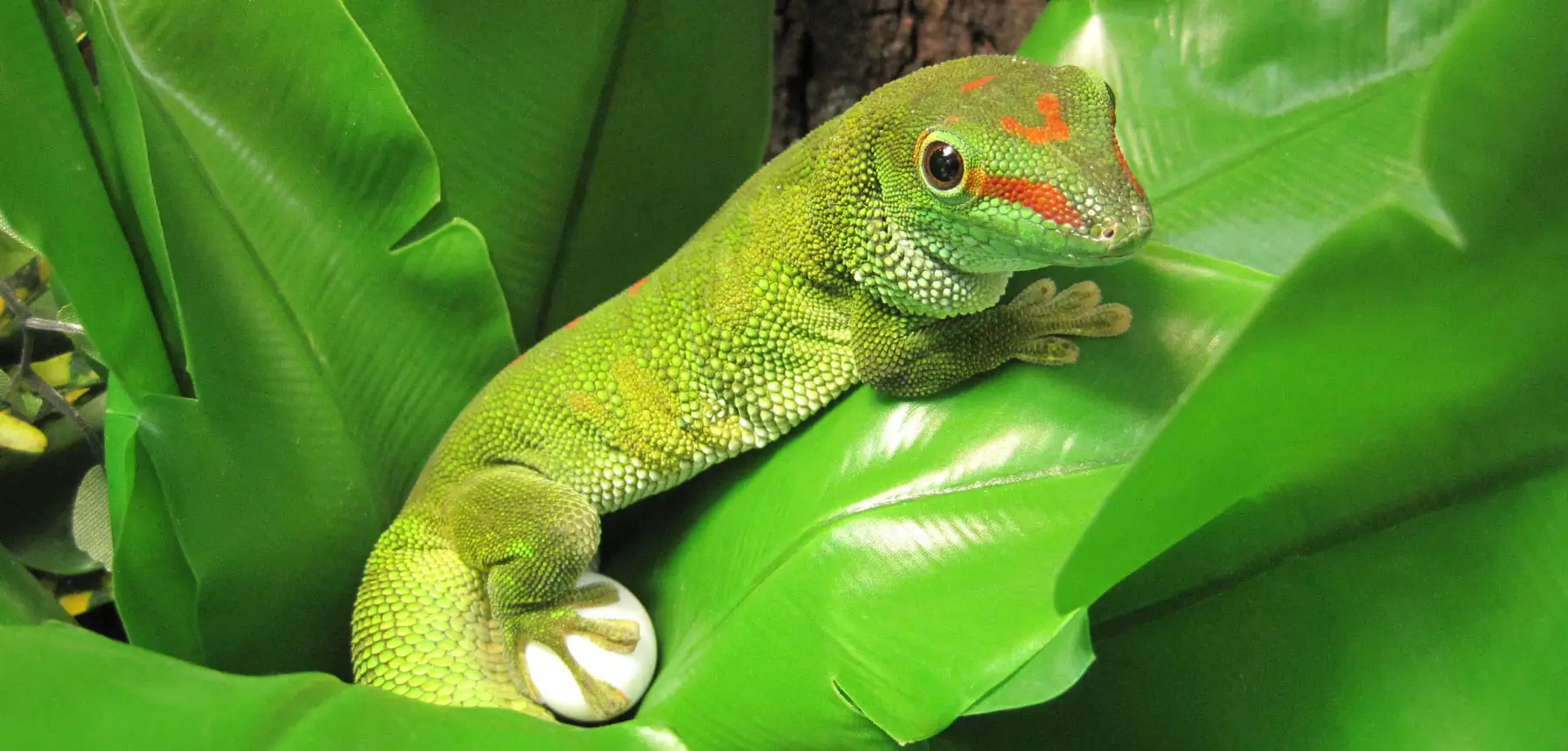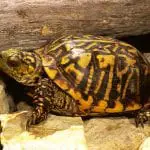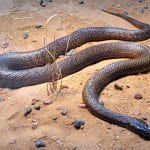Scientific Facts
| Common Name: | Madagascar Giant Day Gecko |
| Scientific Name: | Phelsuma Grandis |
| Life Span: | 6 to 8 years in captivity |
| Size: | 12 inches |
| Habitat: | Tropical and subtropical forests |
| Country of Origin: | Northern Madagascar |
Physical Description
The Madagascar Giant Day Gecko is a diurnal species of day geckos part of more than 70 species and large subspecies. It has earned its name from its size and is native to tropical and subtropical areas in northern Madagascar.
This colorful lizard reaches a length of 30 cm from head to tail. The body is bright or neon green while some have bluish-green colors. There are red stripes that start from the nostril to the eyes, and there are also red bars and dots at the back.
These red markings vary from one lizard to another while some have no red marks at all. Meanwhile, adult Madagascar Giant Day Geckos have large sacs found along their necks; these are calcium sacs. Young and juvenile day geckos have brighter colors and gradually fade as they turn to adults. The underside is creamy white.
Life Span
The Madagascar Giant Day Gecko has three life stages just like other gecko species:
Hatchlings
Hatchlings are bright green to neon green in color and already has the distinct red stripes on the face and large black eyes. The hatchlings are cute with their large heads and smaller bodies. The markings at the back will eventually become brighter as the gecko becomes older. The newly hatched baby gecko slightly larger than the tip of a pencil.
Juvenile
During the juvenile stage, both male and female Madagascar Giant Day Geckos will grow at the same rate. The once bright green body will become a duller color, but still, the head is large while the snout is more elongated.
Adult
Adult Madagascar Giant Day Geckos eventually becomes mature and ready to mate. The colors are duller, and the spots are slowly becoming thinner or less pronounced. The eyes are still black, with a tinge of gold when light is reflected.
Eating Habits
The Madagascar Giant Day Gecko is an omnivore. It can devour as many insects as it wants, and thus, it eats a lot of insects in the wild. When placed in captivity, these lizards will eat live food like mealworms and crickets. You may also feed this gecko waxworm, silkworms, and other insects.
Gut loading is a way to give your pet supplements and nutrients to ensure good growth and development. Handlers use commercial gut load mix or baby cereal, dog or cat food, or fish food. Other pet owners gut load with romaine lettuce or other leafy greens. Meanwhile, use calcium powder to dust food before giving it to your pet.
And because this gecko is awake at daytime, you must load its food in the tank in the morning when it is very active. Never leave prey roaming inside the tank in the evening because this can wake the gecko and interrupt its rest or sleep.
This gecko may also eat fruits, leafy greens, nectar, and pollen. Some geckos have been observed to eat their young, and it’s not known if this is due to hunger or a way to exert dominance.
Water
Madagascar Giant Day Geckos need freshwater inside its tank. You must leave a dish of clean water inside its cage. Change this daily and make sure to clean the dish to prevent bacterial contamination inside the cage and infection.
The gecko can use this water to cool itself down when the temperature and humidity are too much inside the tank. Apply water by spraying it on the leaves and the tank walls. The gecko will gladly lick this to drink water.
Development, Reproduction, and Breeding
Female day geckos will lay two eggs in every clutch, and several clutches may be laid in a year. The eggs are hard and need a lot of calcium to develop. Females use their calcium sacs along their necks to collect calcium from their diets. These sacs will grow large and will deplete slowly as the calcium is used for egg-laying. The hatchlings will come out of the shell after 48 to 80 days, and this is according to the temperature of the surroundings.
People who want to breed Madagascar Giant Day Geckos must follow strict rules and parameters. The captive care of juveniles is the same as adults. Tanks should have constant temperature and humidity for the young to survive.
Common Health Problems
Here are the common problems that Madagascar Giant Day Geckos experience:
Parasites
Most reptiles come with parasites that seem to not affect their health. However, these can become dangerous when the gecko becomes stressed or suffer any immune system condition. The parasites can multiply, and this can affect the gecko’s health. Also, these may worsen and can affect other animals and humans. And to stop parasites and infections from spreading, quarantine a new lizard at all times. Always check for signs of parasitic infections like smelly or runny dropping, weight loss, an enlarged abdomen, anorexia, and lack of energy.
Poor shedding
Take note of signs of shedding difficulties like skin flakes, skin clinging on the tail, or the eyes and signs of restlessness. Any stuck skin should be removed right away and for dryness (the usual cause of poor shedding) soak it in a dish of warm water for a few minutes. But for any severe shedding effects, consult a vet. A vet can remove shedding and will treat wounds or cuts due to incomplete shedding.
Metabolic Bone Disease
MBD is the lack of calcium in bones and symptoms; this may occur over time but may also show acute symptoms like bowed legs, a rubbery jaw, and kinks in the spine. Some hatchlings are born with the inability to manufacture calcium, and this leads to MBD. Also, females that hatch eggs require increased calcium in their diets.
MBD is reversible by increasing vitamin D3 and calcium. There are available calcium supplements and proper UV lighting to help improve vitamin D3 levels in the lizard’s body.
Preventing Illness
To prevent illness, keep the tank temperature and humidity at the best levels. Place a bowl of water in the tank because this will not just be its water dish but also a way to enhance humidity inside the tank.
You must keep your tank clean because a dirty, unkempt tank can lead to the growth of bacteria inside the tank, which can affect the health of your lizard. Use a good cleaning product and never products that leave residue and toxins, which again can harm your gecko.
Always give the best food for your gecko and feed it organic food. Never capture insects and worms in your yard because these may have toxins coming from pesticides, which can also affect the health of your gecko. Take advantage of live insects to gut feed so you can give your gecko supplements and nutrients it needs
And of course, remember to quarantine new lizards. These new pets may bring pests, mites, and illnesses, so you must monitor its health condition before you introduce it to the main gecko tank. Some breeders wait till a week while some months to quarantine a new lizard.
Behavior
To better understand your pet Madagascar Giant Day Gecko, get to know its many unique behaviors
Territorial lizard
Day geckos are very territorial and will tend to quarrel with other males if one crosses into his area. A male will only accept females to enter their area.
Seriously injure females
When a female enters a male’s territory, and she wants to escape, she can’t. The male won’t let her, and he will go as far as hurting her seriously just to keep her in his territory. This is why male and female day geckos should be kept in separate tanks.
Moves slowly
Madagascar Giant Day Geckos are known to move very slowly when they are crawling about. But when they are startled can move very fast.
Eat their young
Yes, these lizards could eat their young, and it is unknown why they do this. Some say that this could be a form of dominance or a male showing his prowess to a female.
Cleans their eyes often
Because day geckos don’t have eyelids, they will frequently lick their eyes to clean them. You can sometimes see day geckos staring at nothingness and flipping its tongue in and out to clean its eyes.
Docile behavior to handlers
One of the reasons why the Madagascar Giant Day Gecko is a popular pet is because of its docile behavior towards its handlers. Many first-time gecko or lizard owners prefer this species because of its even temperament and nature. It won’t bite and will just love to be admired.
Can climb walls
Madagascar Giant Day Geckos have sticky feet or adhesive lamellae, and this allows it to walk or climb tank walls. This is why you must secure your tank always with a durable cover and a secure lid.
Will grow its tailback
One of the adaptations of the Madagascar Giant Day Gecko is its ability to shed off its tail when it is attacked, stressed or threatened. The lost tail will be replaced with a rounded tail that looks different from its usual tail.
Diurnal animal
There are day geckos that will stay active at night or in the morning. So, you must monitor your lizard’s feeding and energy levels to find out when is the best time to feed and to turn off the lights.
Shedding
Shedding is ideally complete, but some geckos may have incomplete shedding. This happens wherein parts of the tail, hands, feet, and eyes shed in flakes and skin may also remain.. This can indicate problems with humidity and metabolic conditions as well.
To treat incomplete shedding and to help geckos shed completely, improve humidity levels in the tank. Soak it in warm water for at least a few minutes to loosen dead skin. Usually, shedding happens in juveniles and less frequently in adults. Also, take note that shedding is stressful to most geckos, so it’s always best to leave your pet alone and intervene only when there are problems with shedding.
Habitat
The ideal tank size is a 10-gallon to a 20-gallon enclosure or terrarium. One or two geckos may remain in a large tank, but during breeding time, one male to more females is the best ratio for breeding success.
Place a cover at the top using a screen cover to prevent other pets from entering the tank and your pet from escaping. Place a lock on the cover to secure the tank. The tank must be placed in a quiet environment so that this gecko can sleep and recuperate. Some breeders place their geckos in a small plastic container, but this is too small even for a gecko.
Lighting, Humidity, and Temperature
The Madagascar Giant Day Gecko needs an efficient lighting system. Incandescent light is the most efficient according to pet owners, and a minimum of 12 hours of light to mimic daylight is the best amount of light to improve health and tank environment.
Your tank must also sit on top of an under-cage heating pad. This will keep the tank interiors at 75 to 90 degrees Fahrenheit in the morning and 85 to 90 degrees Fahrenheit in the evenings. Another way to improve humidity is to apply a spray of water like a mister. Use a humidifier for more accurate humidity levels. And, a bowl of water is a good way to maintain humidity. Keep your lizard’s water clean and fresh daily always.
Tank Bedding and Accessories
Madagascar Giant Day Geckos should have areas where it can sleep peacefully. You can make the enclosure as elaborate as you want, but doing so can make it harder for you to see your pet. Also, take note that your pet’s safety is the most important of all. The accessories inside the tank should be safe, must have no pointed edges that can hurt your gecko.
You can also use accessories made from things you have at home like a clay pot, a shoebox, or a plastic container. Place one side near the heat source and one hide farther away in case your pet wants to sleep longer.
For the bedding or substrate, use paper substrate for easy cleaning. Use newspaper, butcher, or packing paper or paper towel. Do not use sand because the gecko can ingest this, and this can impact its stomach or intestine. Do not use substrate materials with too much smell, which can instantly affect the health of geckos.
Sanitation
Clean your gecko’s cage with effective cleaners. You can choose from homemade or basic cleaners and commercially available cleaners. One good idea is dishwashing soap, bleach, and water. Be sure to rinse everything before you place the gecko inside. You may also use baking soda to clean the tank and remove odors.
If you want to use chemical cleaners, follow the instructions carefully. Never use two chemical products at a time and always rinse well with running water. Use paper towels to dry the walls, flooring, and accessories before placing your pet in. You may also remove disease-causing bacteria with a splash of boiling water and some soap.
Availability – Where to Get One?
You can get a Madagascar Giant Day Gecko from a local pet store or reptile trade shop. This lizard is usually from a trader or local supplier, and the price for a regular Madagascar Giant Day Gecko is around $45 to $250 depending on the size, color, markings, and age.
How to Care for a Madagascar Giant Day Gecko
Giant Day Geckos should be cared for using the following techniques:
- Learn how to handle your gecko so it will learn to trust you in return. You must handle it early during the hatchling and juvenile stages.
- Take note that any stress can affect your gecko’s health. You must keep your lizard stress-free to keep it happy and healthy in the tank.
- Avoid overcrowding and use a larger tank. Place one lizard in one tank and use smaller tanks for breeding.
- Maintain good humidity inside the tank. This will prevent illnesses, enhance shedding, and keep your lizard healthy. If you have a bigger tank, invest in a humidifier to control humidity effortlessly.
- Keep the tank in a quiet area and maintain peace when the gecko is asleep. Feed it only when it’s awake and about. Since day geckos are diurnal, find out your gecko’s preferred time to relax and eat before you feed it.
- Never reuse your substrate. Change this frequently to prevent mold, bacteria, and parasites. A good substrate should be used but avoid using sand because a gecko may ingest sand as it eats, and this can accumulate inside its gut, causing illness.
- Change the water inside the bowl. Keep water fresh and clean, and don’t remove this inside the tank because this helps improve humidity inside the cage.
- Feed your gecko the best food. A wide variety of insects and produce will do. Take this as a good way to feed your geckos supplements and nutrients by gut feeding.
- Take your pet to the vet regularly, especially when it’s sick, wounded, or lethargic.
FAQ Section
Do giant day geckos love to be handled?
Some do while some don’t But no matter what, handling a gecko is the best way to get to know its owner. Use a simple trick to get a gecko on your hand; place a fruit or cricket on your hand for it to eat.
Are giant day geckos aggressive?
These geckos can become aggressive between males, females, and males and females. If you notice aggression, separate the two by placing these in separate tanks.
Will giant day geckos need a heat lamp?
Yes, because of their size, giant day geckos need more space and the ideal ambient temperatures from 75 to 80 degrees Fahrenheit. A basking area with a temperature of 85 to 90 degrees Fahrenheit is ideal.
How large does a day gecko tank have to be?
Young giant day geckos need tanks as small as 10 gallons like a small glass terrarium. This will leave them more space and will allow you to clean the tank easily.
Can day geckos live with tree frogs?
Day geckos may live well with medium-sized tree frogs. The day geckos can’t fight the tree frog and will not battle for territory as well.
Do day geckos need to live food?
Yes, geckos like the giant day gecko need live food. They will eagerly feed on mealworms, crickets, and other insects. Also, add supplements or nutrients in your gecko’s diet by gut load live food with nutrients and feed to your gecko at once.
How long does giant day gecko eggs hatch?
At 82 degrees Fahrenheit and 60% humidity, eggs will hatch in just 55 to 65 days. Eggs that are incubated in cooler temps can take longer to hatch.
How many days will a day gecko do without eating?
Older juveniles and adults can go without eating for 10 days to weeks. Geckos should have a water dish inside the tank to provide constant dehydration.
How to get rid of geckos that are pests?
Sometimes common house geckos are just too much and can become pests. To remove these, you can use mothballs, garlic, pepper spray, onion slices, and coffee. Try any of these, and surely you’ll get rid of pesky house geckos at home easily and safely.



